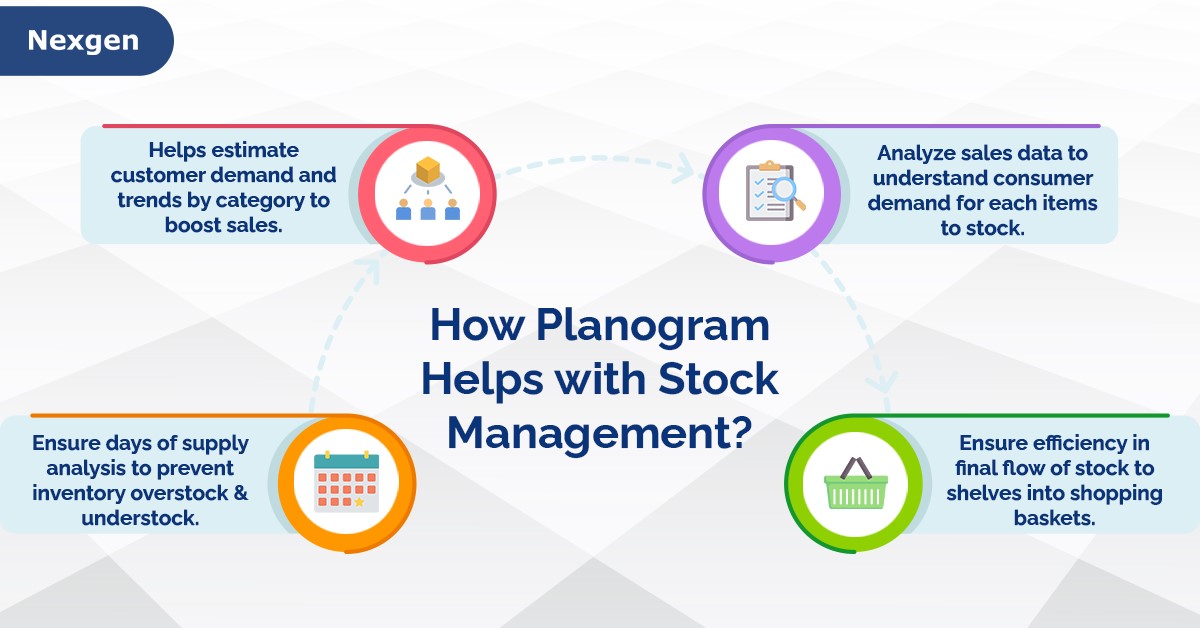Stocking the right amount of inventory can be a challenging task for most retailers. If you overstock, you are left with costly excess inventory. On the other hand, if you understock, you will lose a lot of sales.
Over half of retail businesses use no inventory tools at all. This leaves you at high risk of poor inventory management. To avoid this, you must ensure that you are replenishing your inventory on time and efficiently restocking your best-selling SKUs. However, most retail stores fail to plan their inventory strategically and end up overstocking inventory in a bid to prevent stockouts. So, how do you make informed decisions when it comes to stocking your store? Knowing how much to stock can be determined with the right planogram inventory management software.
How Planogram Helps with Stock Management?
As a retailer, it is expensive and inefficient to replenish shelves manually with stock on a regular basis, filling up each product as soon as each one runs out of the shelf. It would be inconvenient for shoppers who are trying to get products on the shelves, but it would also be very time-consuming and costly for the store. This is where visual merchandising planograms come in. Well-designed planograms help retailers control shelf space by communicating to retail store staff exactly where products should be placed in relation to each other, how many facings they should get, and on which shelves they should go. This ensures the final flow of stock to shelves and from shelves into shopping baskets.

Understocking V/S Overstocking: Causes & Consequences
Offering the right products at the right time and place is important in today’s retail business. Mistakes like understocking or overstocking can cause huge losses. Let us begin with understocking and the reasons for it. If a shopper walks into your store looking for a product and finds that it has run out of stock, they will leave dissatisfied and frustrated. If it happens often enough, they might not return to your store anymore. You can prevent out of stock by ensuring planogram days of supply analysis in your store. It will help you understand the number of days a product is expected to last before it is restocked. Other factors like unexpected changes in the market, poor shelf planning, and not analyzing sales data causes understock. This results in huge loss, dissatisfying customers and losing brand image.
Meanwhile, overstock is the exact opposite. For instance, Imagine you are an electronics retailer who stocks laptops, digital cameras, and microphones. The sales manager for a particular laptop brand walks into your store one day and notices you only have notebook type laptops and not touchscreen tablets in stock. The sales manager wants to sell more and persuade you to obtain additional stock for touchscreen tablets. One month later, none of your new stock has sold. Such overstocking can cause problems due to poor planning, giving in to your suppliers, and not understanding the market well enough. This will result in providing no shelf space for new items and capital tied up in the inventory.
How to Prevent Understock & Overstock in Retail?
- Understand customer demand for each product type: Understand consumer demand for each product type before stocking the products. For example, if your shopper demands high-end products, try not to stock cheaply made brands or products packaged in boxes with unreadable labels. You can look at your six months of sales data to get an idea of sales trends. This will help you stock the right inventory on shelves to satisfy your customer’s needs and boost your sales. Let us take the example of electronics retailers again. And let us say, most shoppers do not like to spend more on a camera than a laptop. They might spend a fortune on a laptop, since it can be useful for many reasons. Thus, you can prevent overstocking a product by looking at what your customers purchase, and understanding what their buying habits are.
- Understand customer demand trends by category: By looking at the planogram sales data based on category, segment, and sub-segment, you can estimate the customer demand and plan accordingly. If you are planning to launch a new product in the market, it would be best to test a product in your store first before overstocking to waste your money. Let us take the example of 5G smartphones released in the market a few years ago. It was a new trend, and if your shopper came in to buy such a product, they might not know that they could not use it yet since the 5G network was limited to a few countries. That meant most customers would request a refund or return the item. Imagine if your supplier had compelled you to stock the product in your store, when it was too early to hit the market. Your store would have wasted money and overstocked such items where your shoppers could not use them in most countries. This will result in a huge loss for retail stores.
Overview of Nexgen POG
Nexgen POG is a robust and user-friendly cloud-based visual merchandising tool. It is designed for quick and efficient planogramming with minimal effort. Planogram in retail can be designed by easily dragging and dropping the products. The multi-device compatibility feature of POG allows you to obtain, share and edit planogram on any device, including your phone. It helps in designing store-specific planograms for increased product visibility and sales.
Get Your Free Trial Now!